Page 2052 of 4378
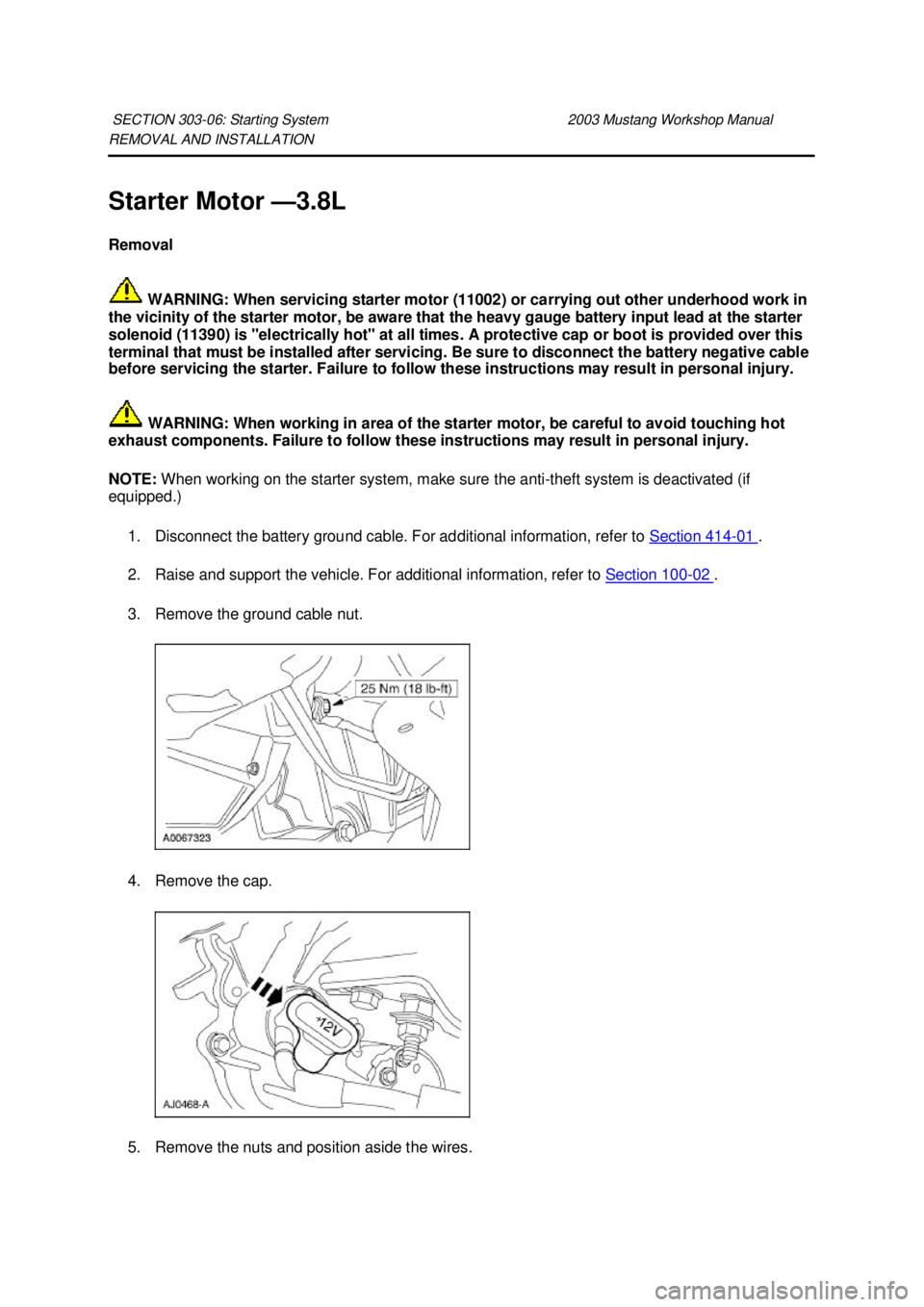
REMOVAL AND INSTALLATION
Starter Motor —
3.8L
Removal
WARNING: When servicing starter motor (11002) or carrying out other underhood work in
the vicinity of the starter motor, be aware that the heavy gauge battery input lead at the starter
solenoid (11390) is "electrically hot" at all times. A protective cap or boot is provided over this
terminal that must be installed after servicing. Be sure to disconnect the battery negative cable
before servicing the starter. Failure to follow these instructions may result in personal injury.
WARNING: When working in area of the starter motor, be careful to avoid touching hot
exhaust components. Failure to follow these instructions may result in personal injury.
NOTE: When working on the starter system, make sure the anti- theft system is deactivated (if
equipped.)
1. Disconnect the battery ground cable. For additional information, refer to Section 414 - 01 .
2. Raise and support the vehicle. For additional information, refer to Section 100 - 02 .
3. Remove the ground cable nut.
4. Remove the cap.
5. Remove the nuts and position aside the wires.
SECTION 303-
06: Starting System 2003 Mustang Workshop Manual �K�l�j . 1 �b�a
22003 Mustang Workshop Manual
18. 11. 2011file:///C:/Ford/2000 - 2004/tsocache/SHEF_4464/S3B~us~en~ ...
Page 2054 of 4378
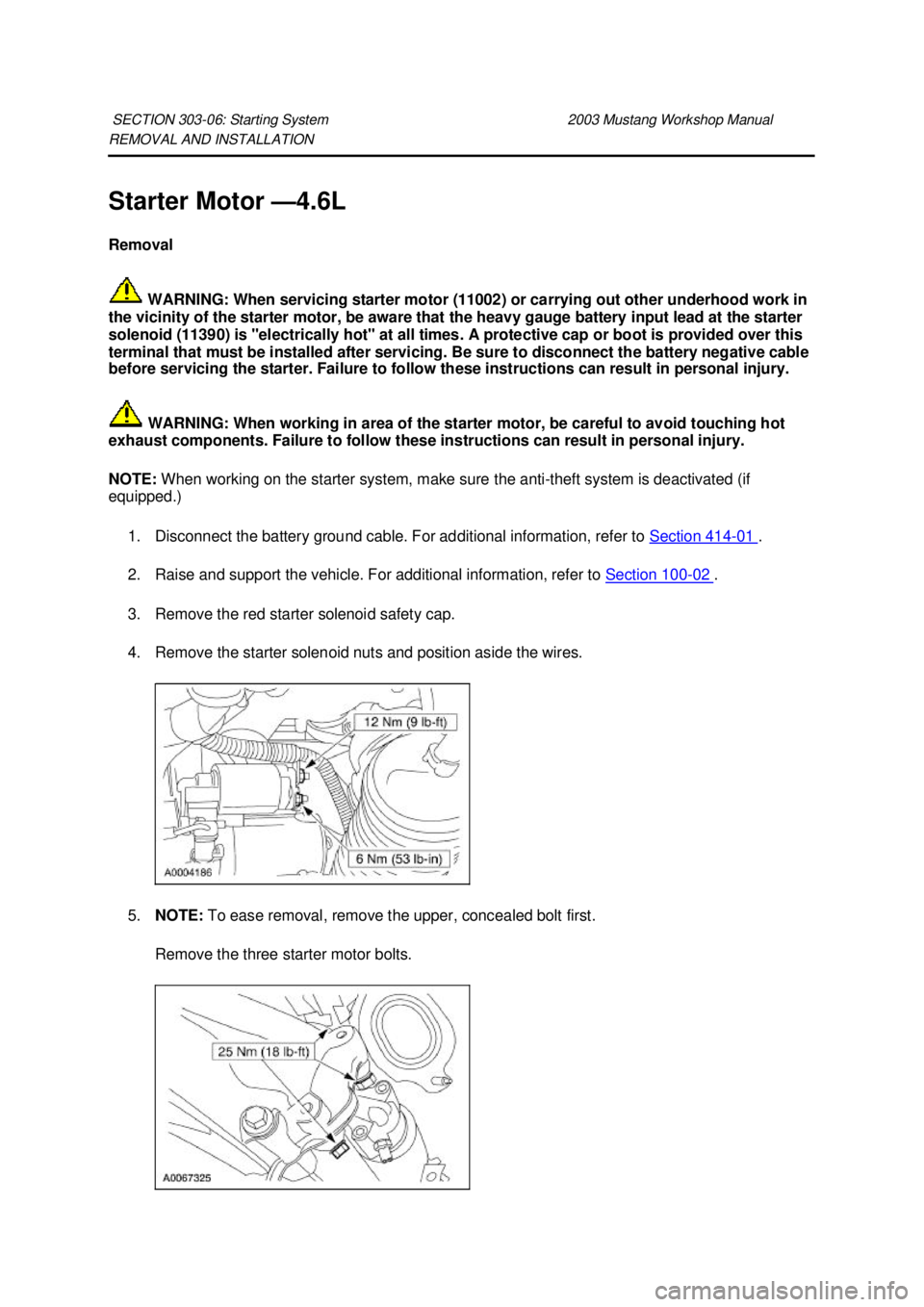
REMOVAL AND INSTALLATION
Starter Motor —
4.6L
Removal
WARNING: When servicing starter motor (11002) or carrying out other underhood work in
the vicinity of the starter motor, be aware that the heavy gauge battery input lead at the starter
solenoid (11390) is "electrically hot" at all times. A protective cap or boot is provided over this
terminal that must be installed after servicing. Be sure to disconnect the battery negative cable
before servicing the starter. Failure to follow these instructions can result in personal injury.
WARNING: When working in area of the starter motor, be careful to avoid touching hot
exhaust components. Failure to follow these instructions can result in personal injury.
NOTE: When working on the starter system, make sure the anti- theft system is deactivated (if
equipped.)
1. Disconnect the battery ground cable. For additional information, refer to Section 414 - 01 .
2. Raise and support the vehicle. For additional information, refer to Section 100 - 02 .
3. Remove the red starter solenoid safety cap.
4. Remove the starter solenoid nuts and position aside the wires.
5. NOTE: To ease removal, remove the upper, concealed bolt first.
Remove the three starter motor bolts.
SECTION 303-
06: Starting System 2003 Mustang Workshop Manual �K�l�j . 1 �b�a
32003 Mustang Workshop Manual
18. 11. 2011file:///C:/Ford/2000 - 2004/tsocache/SHEF_4464/S3B~us~en~ ...
Page 2176 of 4378
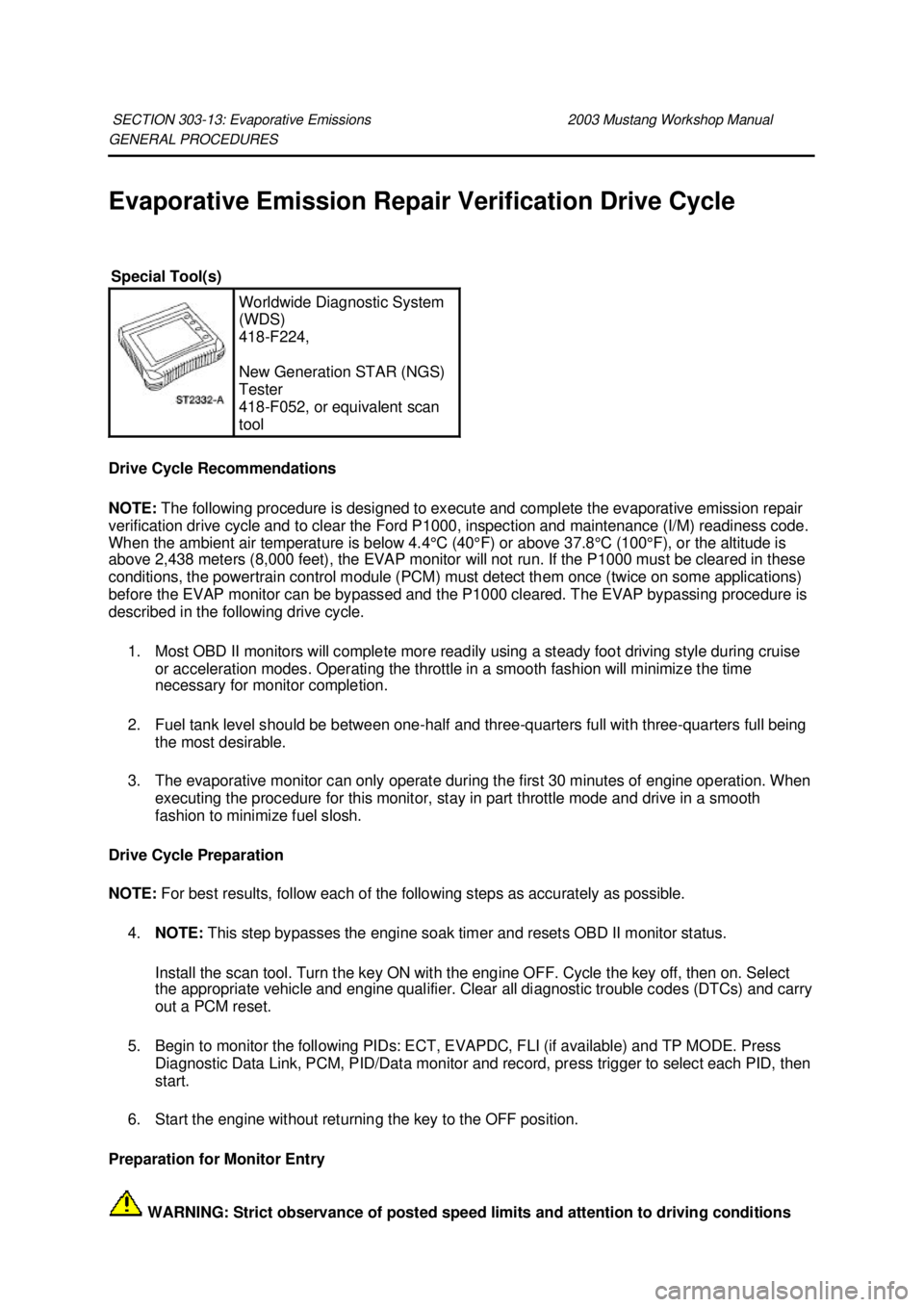
GENERAL PROCEDURES
Evaporative Emission Repair Verification Drive Cycle
Drive Cycle Recommendations
NOTE:
The following procedure is designed to execute and complete the evaporative emission repair
verification drive cycle and to clear the Ford P1000, inspection and maintenance (I/M) readiness code.
When the ambient air temperature is below 4.4°C (40°F) or above 37.8°C (100°F), or the altitude is
above 2,438 meters (8,000 feet), the EVAP monitor will not run. If the P1000 must be cleared in these
conditions, the powertrain control module (PCM) must detect them once (twice on some applications)
before the EVAP monitor can be bypassed and the P1000 cleared. The EVAP bypassing procedure is
described in the following drive cycle.
1. Most OBD II monitors will complete more readily using a steady foot driving style during cruise or acceleration modes. Operating the throttle in a smooth fashion will minimize the time
necessary for monitor completion.
2. Fuel tank level should be between one- half and three-quarters full with three- quarters full being
the most desirable.
3. The evaporative monitor can only operate during the first 30 minutes of engine operation. When executing the procedure for this monitor, stay in part throttle mode and drive in a smooth
fashion to minimize fuel slosh.
Drive Cycle Preparation
NOTE: For best results, follow each of the following steps as accurately as possible.
4. NOTE: This step bypasses the engine soak timer and resets OBD II monitor status.
Install the scan tool. Turn the key ON with the engine OFF. Cycle the key off, then on. Select
the appropriate vehicle and engine qualifier. Clear all diagnostic trouble codes (DTCs) and carry
out a PCM reset.
5. Begin to monitor the following PIDs: ECT, EVAPDC, FLI (if available) and TP MODE. Press Diagnostic Data Link, PCM, PID/Data monitor and record, press trigger to select each PID, then
start.
6. Start the engine without returning the key to the OFF position.
Preparation for Monitor Entry
WARNING: Strict observance of posted speed limits and attention to driving conditions
SECTION 303-
13: Evaporative Emissions 2003 Mustang Workshop Manual Special Tool(s)
Worldwide Diagnostic System
(WDS)
418-
F224,
New Generation STAR (NGS)
Tester
418- F052, or equivalent scan
tool �K�l�j . 1 �b�a
32003 Mustang Workshop Manual
18. 11. 2011file:///C:/Ford/2000 - 2004/tsocache/SHEF_4464/S3B~us~en~ ...
Page 2179 of 4378
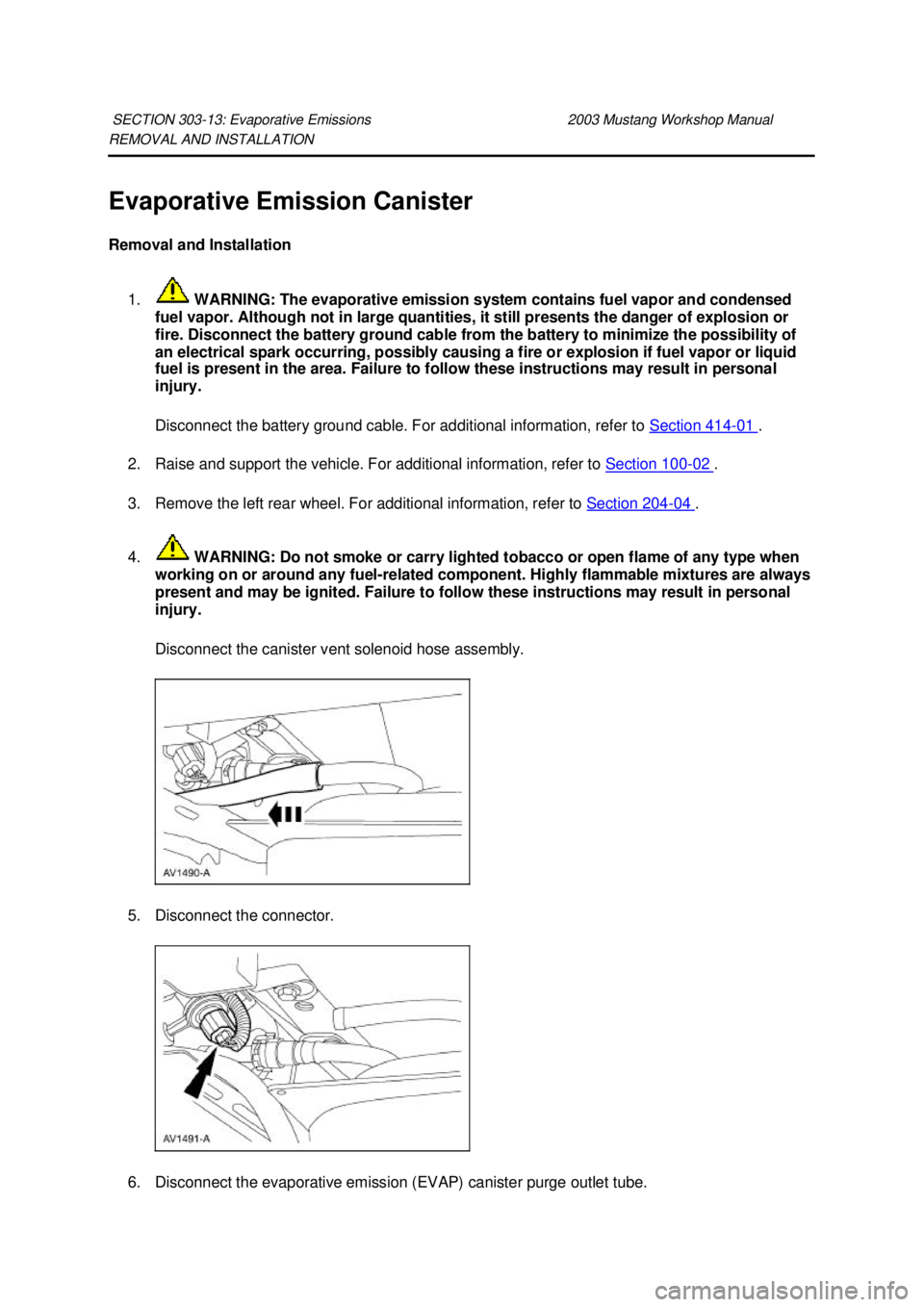
REMOVAL AND INSTALLATION
Evaporative Emission Canister
Removal and Installation
1. WARNING: The evaporative emission system contains fuel vapor and condensed
fuel vapor. Although not in large quantities, it still presents the danger of explosion or
fire. Disconnect the battery ground cable from the battery to minimize the possibility of
an electrical spark occurring, possibly causing a fire or explosion if fuel vapor or liquid
fuel is present in the area. Failure to follow these instructions may result in personal
injury.
Disconnect the battery ground cable. For additional information, refer to Section 414 - 01 .
2. Raise and support the vehicle. For additional information, refer to Section 100 - 02 .
3. Remove the left rear wheel. For additional information, refer to Section 204 - 04 .
4. WARNING: Do not smoke or carry lighted tobacco or open flame of any type when
working on or around any fuel- related component. Highly flammable mixtures are always
present and may be ignited. Failure to follow these instructions may result in personal
injury.
Disconnect the canister vent solenoid hose assembly.
5. Disconnect the connector.
6. Disconnect the evaporative emission (EVAP) canister purge outlet tube.
SECTION 303-
13: Evaporative Emissions 2003 Mustang Workshop Manual �K�l�j . 1 �b�a
32003 Mustang Workshop Manual
18. 11. 2011file:///C:/Ford/2000 - 2004/tsocache/SHEF_4464/S3B~us~en~ ...
Page 2182 of 4378

REMOVAL AND INSTALLATION
Evaporative Emission Canister Purge Valve
Removal and Installation
1. WARNING: The evaporative emission system contains fuel vapor and condensed
fuel vapor. Although not in large quantities, it still presents the danger of explosion or
fire. Disconnect the battery ground cable from the battery to minimize the possibility of
an electrical spark occurring, possibly causing a fire or explosion if fuel vapor or fuel
liquid is present in the area. Failure to follow these instructions may result in personal
injury.
Disconnect the battery ground cable. For additional information, refer to Section 414 - 01 .
2. Raise and support the vehicle. For additional information, refer to Section 100 - 02 .
3. Remove the RH front wheel. For additional information, refer to Section 204 - 04 .
4. Remove the right front splash shield. 1. Remove the three screws.
2. Remove the five pin- type retainers.
5. Disconnect the connector.
6. Disconnect the main emission vacuum control connector.
SECTION 303-
13: Evaporative Emissions 2003 Mustang Workshop Manual �K�l�j . 1 �b�a
32003 Mustang Workshop Manual
18. 11. 2011file:///C:/Ford/2000 - 2004/tsocache/SHEF_4464/S3B~us~en~ ...
Page 2183 of 4378
7.
WARNING: Do not smoke or carry lighted tobacco or open flame of any type when
working on or around any fuel- related component. Highly flammable mixtures are always
present and may be ignited. Failure to follow these instructions may result in personal
injury.
Disconnect the evaporative emission (EVAP) canister purge outlet tube.
8. Disconnect the EVAP return tube.
9. Remove the nuts and the EVAP canister purge valve. �K�l�j . 2 �b�a
32003 Mustang Workshop Manual
18. 11. 2011file:///C:/Ford/2000 - 2004/tsocache/SHEF_4464/S3B~us~en~ ...
Page 2249 of 4378
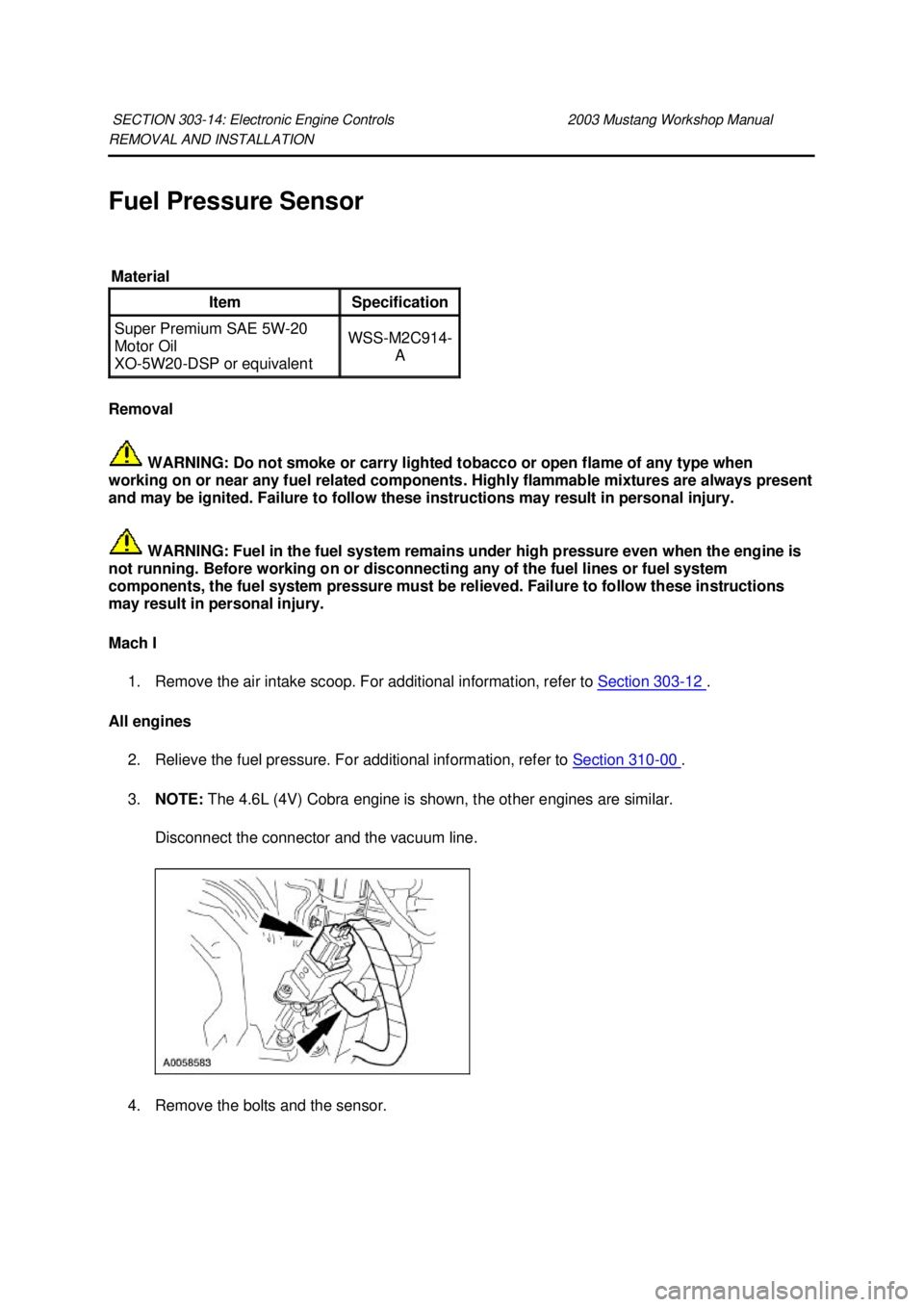
REMOVAL AND INSTALLATION
Fuel Pressure Sensor
Removal
WARNING: Do not smoke or carry lighted tobacco or open flame of any type when
working on or near any fuel related components. Highly flammable mixtures are always present
and may be ignited. Failure to follow these instructions may result in personal injury.
WARNING: Fuel in the fuel system remains under high pressure even when the engine is
not running. Before working on or disconnecting any of the fuel lines or fuel system
components, the fuel system pressure must be relieved. Failure to follow these instructions
may result in personal injury.
Mach I
1. Remove the air intake scoop. For additional information, refer to Section 303 - 12 .
All engines 2. Relieve the fuel pressure. For additional information, refer to Section 310 - 00 .
3. NOTE: The 4.6L (4V) Cobra engine is shown, the other engines are similar.
Disconnect the connector and the vacuum line. 4. Remove the bolts and the sensor. SECTION 303-
14: Electronic Engine Controls 2003 Mustang Workshop Manual Material
Item Specification
Super Premium SAE 5W-20
Motor Oil
XO- 5W20- DSP or equivalent WSS-
M2C914-
A �K�l�j . 1 �b�a
22003 Mustang Workshop Manual
18. 11. 2011file:///C:/Ford/2000 - 2004/tsocache/SHEF_4464/S3B~us~en~ ...
Page 2369 of 4378
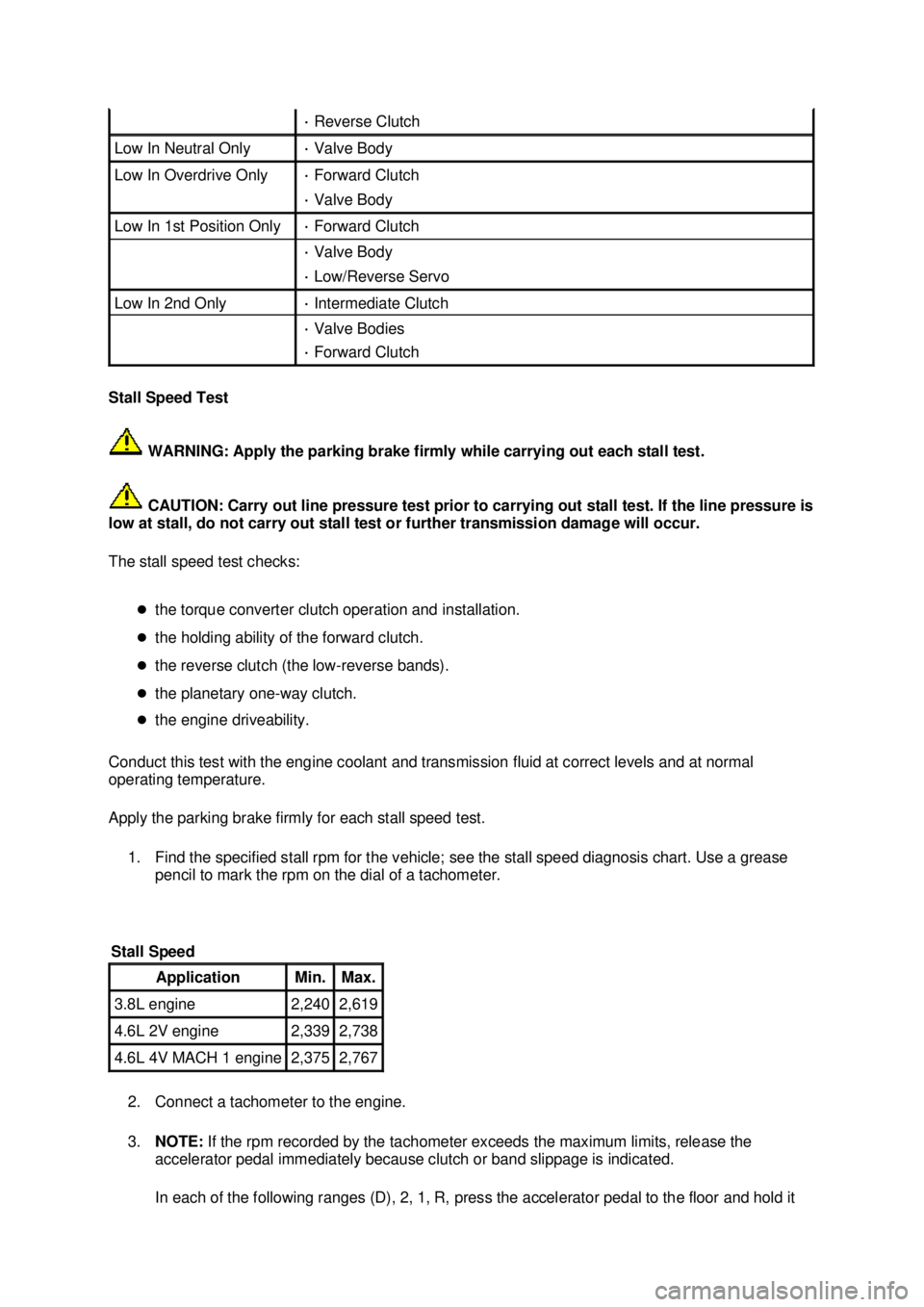
Stall Speed Test
WARNING: Apply the parking brake firmly while carrying out each stall test.
CAUTION: Carry out line pressure test prior to carrying out stall test. If the line pressure is
low at stall, do not carry out stall test or further transmission damage will occur.
The stall speed test checks:
�zthe torque converter clutch operation and installation.
�z the holding ability of the forward clutch.
�z the reverse clutch (the low- reverse bands).
�z the planetary one- way clutch.
�z the engine driveability.
Conduct this test with the engine coolant and transmission fluid at correct levels and at normal
operating temperature.
Apply the parking brake firmly for each stall speed test. 1. Find the specified stall rpm for the vehicle; see the stall speed diagnosis chart. Use a grease pencil to mark the rpm on the dial of a tachometer.
2. Connect a tachometer to the engine.
3. NOTE: If the rpm recorded by the tachometer exceeds the maximum limits, release the
accelerator pedal immediately because clutch or band slippage is indicated.
In each of the following ranges (D), 2, 1, R, press the accelerator pedal to the floor and hold it ·
Reverse Clutch Low In Neutral Only ·
Valve Body Low In Overdrive Only ·
Forward Clutch ·
Valve Body Low In 1st Position Only ·
Forward Clutch ·
Valve Body ·
Low/Reverse Servo Low In 2nd Only ·
Intermediate Clutch ·
Valve Bodies ·
Forward Clutch Stall Speed
Application Min. Max.
3.8L engine 2,240 2,619
4.6L 2V engine 2,339 2,738
4.6L 4V MACH 1 engine 2,375 2,767 �K�l�j . 4 �b�a
72003 Mustang Workshop Manual
18. 11. 2011file:///C:/Ford/2000 - 2004/tsocache/SHEF_2748/S3B~us~en~ ...